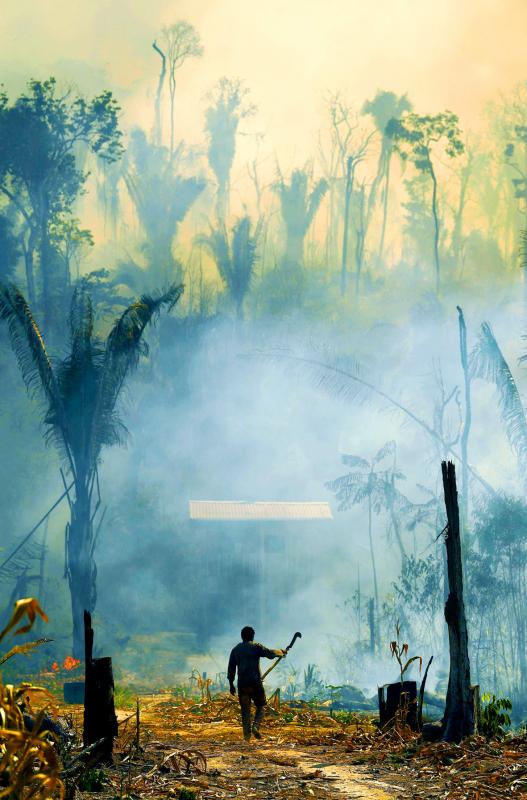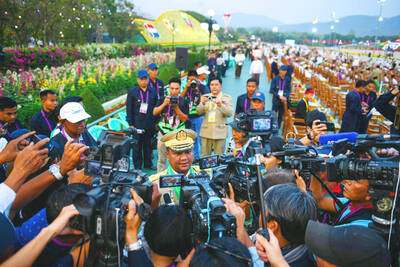Humans have degraded or destroyed about two-thirds of the world’s original tropical rainforest cover, new data revealed, raising alarm that a key natural buffer against climate change is quickly vanishing.
The forest loss is also a major contributor of climate-warming emissions, with the dense tropical forest vegetation representing the largest living reservoir of carbon.
Logging and land conversion, mainly for agriculture, have wiped out 34 percent of the world’s original old-growth tropical rainforests, and degraded another 30 percent, leaving them more vulnerable to fire and future destruction, an analysis by the non-profit Rainforest Foundation Norway said.

Photo: AFP
More than half of the destruction since 2002 has been in South America’s Amazon and bordering rainforests.
As more rainforest is destroyed, there is more potential for climate change, which in turn makes it more difficult for remaining forests to survive, said the report’s author Anders Krogh, a tropical forest researcher. “It’s a terrifying cycle.”
The total lost from 2002 to 2019 was larger than the area of France, he found.
The rate of loss in 2019 roughly matched the annual level of destruction over the past 20 years, with a soccer field’s worth of forest vanishing every 6 seconds, according to another recent report by the World Resources Institute.
The Brazilian Amazon has been under intense pressure in recent decades, as an agricultural boom has driven farmers and land speculators to torch plots of land for soybeans, beef and other crops.
That trend has worsened since 2019, when Brazilian President Jair Bolsonaro took office and began weakening environmental enforcement.
However, the Amazon also represents the best hope for preserving what rainforest remains. The Amazon and its neighbors — the Orinoco and the Andean rainforest — account for 73.5 percent of tropical forests still intact, Krogh said.
The new report “reinforces that Brazil must take care of the forest,” said Ane Alencar, a geographer with the Amazon Environmental Research Institute who was not involved in the work. “Brazil has the biggest chunk of tropical forest in the world and is also losing the most.”
Southeast Asian islands, mostly belonging to Indonesia, collectively rank second in terms of forest destruction since 2002, with much of those forests cleared for palm oil plantations.
Central Africa ranks third, with most of the destruction centered around the Congo River basin, due to traditional and commercial farming, as well as logging.
Forests that were defined in the report as degraded had either been partially destroyed, or destroyed and since replaced by secondary forest growth, Rainforest Foundation Norway said.
That report’s definition for intact forest might be overly strict, said Tasso Azevedo, coordinator of the Brazilian deforestation mapping initiative MapBiomas.
The analysis only counts untouched regions of at least 500km2 as intact, leaving out smaller areas that might add to the world’s virgin forest cover, he said.
Krogh said that this definition was chosen because smaller tracts are at risk of the “edge effect,” where trees die faster and biodiversity is harder to maintain near the edge of the forest.
A forest spanning 500km2 can fully sustain its ecosystem, he said.

In the sweltering streets of Jakarta, buskers carry towering, hollow puppets and pass around a bucket for donations. Now, they fear becoming outlaws. City authorities said they would crack down on use of the sacred ondel-ondel puppets, which can stand as tall as a truck, and they are drafting legislation to remove what they view as a street nuisance. Performances featuring the puppets — originally used by Jakarta’s Betawi people to ward off evil spirits — would be allowed only at set events. The ban could leave many ondel-ondel buskers in Jakarta jobless. “I am confused and anxious. I fear getting raided or even

Eleven people, including a former minister, were arrested in Serbia on Friday over a train station disaster in which 16 people died. The concrete canopy of the newly renovated station in the northern city of Novi Sad collapsed on Nov. 1, 2024 in a disaster widely blamed on corruption and poor oversight. It sparked a wave of student-led protests and led to the resignation of then-Serbian prime minister Milos Vucevic and the fall of his government. The public prosecutor’s office in Novi Sad opened an investigation into the accident and deaths. In February, the public prosecutor’s office for organized crime opened another probe into

RISING RACISM: A Japanese group called on China to assure safety in the country, while the Chinese embassy in Tokyo urged action against a ‘surge in xenophobia’ A Japanese woman living in China was attacked and injured by a man in a subway station in Suzhou, China, Japanese media said, hours after two Chinese men were seriously injured in violence in Tokyo. The attacks on Thursday raised concern about xenophobic sentiment in China and Japan that have been blamed for assaults in both countries. It was the third attack involving Japanese living in China since last year. In the two previous cases in China, Chinese authorities have insisted they were isolated incidents. Japanese broadcaster NHK did not identify the woman injured in Suzhou by name, but, citing the Japanese

RESTRUCTURE: Myanmar’s military has ended emergency rule and announced plans for elections in December, but critics said the move aims to entrench junta control Myanmar’s military government announced on Thursday that it was ending the state of emergency declared after it seized power in 2021 and would restructure administrative bodies to prepare for the new election at the end of the year. However, the polls planned for an unspecified date in December face serious obstacles, including a civil war raging over most of the country and pledges by opponents of the military rule to derail the election because they believe it can be neither free nor fair. Under the restructuring, Myanmar’s junta chief Min Aung Hlaing is giving up two posts, but would stay at the